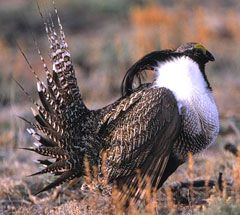
Wildlife advocates say dwindling birds need full protection of Endangered Species Act
Staff Report
FRISCO — Dwindling Gunnison sage-grouse will have to wait a bit long to find out what kind of endangered species protection — if any — they will get.
Following the U.S. Fish and Wildlife Service decision to list the birds as threatened, the agency faces twin lawsuits — one from the State of Colorado, which claims that the birds shouldn’t be listed at all, and another from conservation groups seeking to give the birds the highest level of protection under an “endangered” listing.
The new lawsuit, filed by the Center for Biological Diversity and Western Watersheds Project claims the federal agency bowed to pressure from oil and gas drillers, ranchers, local governments and real estate developers.
“All of the science points to the Gunnison sage grouse being endangered,” said Amy Atwood, endangered species legal director at the Center for Biological Diversity. “I’m appalled that the Fish and Wildlife Service has caved to political pressure and only protected this unique bird as a threatened species.”
The Gunnison sage grouse’s range has declined to just 7 percent of its historic range, with most of the remaining populations in danger of disappearing due to residential development, oil and gas development, grazing and climate change. The Service has acknowledged since 2000 that the species is in need of protection under the Endangered Species Act.
The Service reversed course once before. After drafting a proposed rule to list the species as endangered, political appointees from the Bush administration in 2006 directed agency scientists to remove all protections for the imperiled bird. After an investigation concluded that political officials had improperly interfered in the listing process, the Service put the species back in line for protection.
Following a pair of Endangered Species Act settlement agreements reached in 2011 with environmental organizations, the USFWS proposed to list the species as endangered in January 2013.
“An endangered listing is absolutely necessary to protect the woefully few Gunnison sage grouse that remain on the planet,” said Travis Bruner, executive director of Western Watersheds Project. “Anthropomorphic impacts placed this species in peril, and it is now our responsibility as humans to do everything possible to shield this creature from extinction.”
Species listed as “endangered” receive more powerful legal protections, including prohibitions against killing, harassing or destroying their habitat. But with the weaker “threatened” designation, the Service has indicated it has no plans to offer those protections to the Gunnison sage grouse.
Endangered species generally receive higher priority for recovery plans and a higher likelihood that particular activities will be modified or avoided if they could drive the species over the brink.
The Gunnison sage grouse’s historic range included parts of Colorado, Utah, New Mexico and Arizona, but the species now occurs only in seven small populations in southwestern Colorado and southeastern Utah, with only about 4,000 breeding individuals remaining. Livestock grazing, oil and gas drilling, motorized recreation and urbanization have contributed to the ongoing decline of the bird.
“Full protection is needed in order to save this charismatic bird, and that’s why we’re taking this to court,” said Atwood. “We certainly appreciate the efforts of counties and others to take action to protect habitat for the Gunnison sage grouse, but there’s no reason these activities could not have continued with the endangered designation the grouse clearly warrants.”
The extremist approach of environmental activists regarding the sage grouse is one more way in which their cause is being marginalized. This bird does not deserve the highest level of protection provided by the ESA. Instead, the public-private-local partnership that has developed in the Gunnison area deserves to be appraised, copied and proliferated throughout the western United States. I have seen first-hand the careful trail layout, the controlled access points, the studies detailing the habitat of the grouse and the seasonal closures that protect their breeding areas. Subverting this effort with the reactionary legal wrangling of groups that exist only to file lawsuits is counter-productive and ignorant. The partnership that has developed in this region will produce superior results over any federal designation and unfunded mandate forced on the local authorities. SHAME on the self-appointed wildlife advocates that seek to undo the partnership forged by years of careful study and negotiation. It will ultimately spell the doom of the very creature they purport to protect.
Mark, I’m torn here. Not a big fan of lawsuits at every corner but I consider these groups to be the bulwark against extinction of species large and small. Until there’s an overall shift in government consciousness, these groups and their lawsuits are much needed. We can argue about the specific situation of the Gunnison sage-grouse, but there’s no doubt that many more species would be extinct, or on the brink, if it weren’t for legal actions to hold the government to the high standards of the Endangered Species Act, which is the law of the land.
I agree with you that these groups are an important mechanism in protecting species, but I do not see them doing the hard work of attending planning meetings, conferences, workshops, public comment meetings, state committee hearings, joint working committees, and community outreach groups that myself and many others have attended to achieve exactly the same goals as the purported saviors of the environment.
The use of legal action should be a last resort. It is difficult to respect the position of people who hide behind lawyers to accomplish ill-defined and sweeping goals. The damage done by these attacks negatively affects the efforts of thousands of people working together tirelessly to protect responsible recreational access. Taking legal action is expensive and counter-productive in so many aspects. It makes me wonder: Is concern for the environment is being funded to cover up hidden agendas?